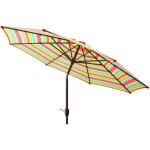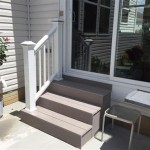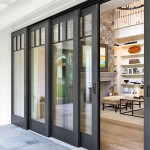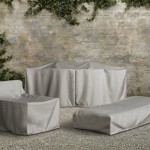Deck Design Ideas for Patios: Maximizing Outdoor Living
Patios serve as transitional spaces, seamlessly connecting indoor living areas with the outdoor environment. Incorporating a deck into the patio design can elevate its functionality and aesthetic appeal. Decks offer a defined space for relaxation, entertainment, and dining, adding value and character to a property. The following explores various deck design ideas tailored for patios, focusing on materials, layouts, and features that enhance the overall outdoor experience.
Careful planning is crucial before embarking on a deck project. Considerations include the patio's existing dimensions, the architectural style of the home, and the intended use of the deck. Budgetary constraints also play a significant role in determining the scope and complexity of the design. It is prudent to consult with a qualified contractor or landscape architect to ensure the project complies with local building codes and regulations.
Choosing the Right Decking Material
The selection of decking material significantly impacts the durability, maintenance requirements, and overall aesthetic of the deck. Several options are available, each with its own advantages and disadvantages.
Wood: Traditional wood decking offers a natural warmth and beauty that is difficult to replicate. Common wood choices include cedar, redwood, and pressure-treated lumber. Cedar and redwood are naturally resistant to decay and insects, making them ideal for outdoor applications. Pressure-treated lumber is chemically treated to resist rot and insect infestation, but it may require more frequent maintenance. All wood decks require regular sealing or staining to protect them from the elements and prevent warping, cracking, or splintering.
Composite Decking: Composite decking is a manufactured material made from recycled plastic and wood fibers. It offers several advantages over traditional wood, including resistance to rot, insects, and fading. Composite decking requires minimal maintenance, typically only needing occasional cleaning with soap and water. It is available in a wide range of colors and textures, allowing for diverse design options. While the initial cost of composite decking may be higher than wood, its long-term durability and low maintenance can make it a cost-effective choice.
PVC Decking: PVC decking is made from 100% plastic and is a highly durable and low-maintenance option. It is resistant to moisture, insects, and fading, making it suitable for areas with harsh weather conditions. PVC decking is available in various colors and textures and can be molded into different shapes and profiles. It is typically more expensive than composite decking but offers superior performance and longevity.
Tropical Hardwoods: Tropical hardwoods such as Ipe, Tigerwood, and Mahogany are known for their exceptional durability and resistance to decay and insects. They offer a rich, natural beauty and can last for decades with proper maintenance. Tropical hardwoods are denser and harder than traditional wood, making them resistant to scratches and dents. However, they are also more expensive and require specialized installation techniques. Their sustainability practices also need to be evaluated to ensure responsible sourcing.
Deck Layout and Design Considerations
The layout and design of the deck should complement the existing patio and enhance the overall flow of the outdoor space. Several factors influence the design, including the size and shape of the patio, the intended use of the deck, and the desired level of privacy.
Multi-Level Decks: For patios with varying elevations, a multi-level deck can create visual interest and define different zones for relaxation, dining, and entertainment. Incorporating steps or ramps between levels can improve accessibility and create a more dynamic outdoor space. Multi-level decks can also be designed to integrate seamlessly with the surrounding landscape, creating a natural and inviting atmosphere.
Built-in Seating: Built-in seating is a practical and aesthetically pleasing addition to any deck. It can be constructed using the same decking material as the deck itself, creating a cohesive and unified look. Built-in seating can be customized to fit the specific dimensions of the deck and can incorporate storage compartments for cushions and other outdoor accessories. Adding comfortable cushions and pillows can enhance the comfort and appeal of built-in seating.
Pergolas and Shade Structures: Pergolas and shade structures can provide respite from the sun and create a more comfortable outdoor environment. A pergola is an open-framed structure typically made of wood or metal, providing partial shade and allowing for the growth of climbing plants. Shade sails are fabric canopies that are suspended between posts, providing a more contemporary and flexible shade solution. The choice of shade structure depends on the desired level of shade, the architectural style of the home, and the budget.
Lighting: Outdoor lighting is essential for creating a safe and inviting deck area. Low-voltage lighting can be used to illuminate pathways, steps, and seating areas, enhancing visibility and safety. String lights can add a festive and whimsical touch, while spotlights can highlight architectural features or landscape elements. Integrated deck lighting, such as recessed lights or under-rail lighting, can create a subtle and sophisticated ambiance. The selection of lighting fixtures should consider energy efficiency, durability, and aesthetic appeal.
Railing Systems: Railing systems are essential for safety and can also contribute to the overall aesthetic of the deck. Options include wood railings, composite railings, metal railings, and glass railings. Wood railings offer a traditional and natural look, while composite railings provide low-maintenance durability. Metal railings can add a contemporary and industrial touch, while glass railings offer unobstructed views of the surrounding landscape. The choice of railing system should consider the style of the home, the desired level of visibility, and the budget.
Incorporating Greenery: Integrating plants and flowers into the deck design can create a more natural and inviting atmosphere. Potted plants, hanging baskets, and vertical gardens can add color and texture to the deck, softening the hard lines of the structure. Consider planting native species that are well-suited to the local climate and require minimal maintenance. Incorporating a small herb garden or vegetable garden can also add a practical and functional element to the deck.
Enhancing Functionality and Aesthetic Appeal
Beyond the basic structure, several features can enhance the functionality and aesthetic appeal of a deck.
Outdoor Kitchen: An outdoor kitchen can transform a deck into a true extension of the home. It can include a grill, countertops, a sink, and storage cabinets, allowing for convenient outdoor cooking and dining. Consider incorporating a built-in refrigerator or wine cooler for added convenience. The design of the outdoor kitchen should complement the overall style of the deck and the home.
Fire Pit or Fireplace: A fire pit or fireplace can create a cozy and inviting atmosphere, extending the use of the deck into the cooler months. Options include wood-burning fire pits, gas fire pits, and electric fireplaces. Fire pits can be built into the deck surface or placed on a separate patio area. Consider the safety aspects of fire features, such as ensuring adequate ventilation and providing a spark screen.
Water Features: Adding a water feature, such as a fountain or a small pond, can create a relaxing and serene atmosphere. The sound of running water can mask unwanted noise and create a sense of tranquility. Water features can be integrated into the deck design or placed nearby, adding a visual and auditory element to the outdoor space. Consider the maintenance requirements of water features, such as cleaning and water treatment.
Storage Solutions: Decks can quickly become cluttered with outdoor furniture, gardening tools, and other accessories. Incorporating storage solutions, such as built-in benches with storage compartments or deck boxes, can help keep the deck organized and clutter-free. Consider the size and style of the storage solutions to ensure they complement the overall design of the deck.
Weather Protection: Depending on the climate, it may be necessary to provide weather protection for the deck. This can include installing a retractable awning, a pergola with a waterproof cover, or a screened-in enclosure. Weather protection can extend the use of the deck and protect outdoor furniture from the elements. Consider the cost and maintenance requirements of different weather protection options.
By carefully considering these design ideas, homeowners can create a patio deck that is both functional and aesthetically pleasing, enhancing their outdoor living experience and adding value to their property. The key is to plan thoroughly, choose durable and appropriate materials, and incorporate features that meet the specific needs and lifestyle of the homeowner.

10 Ideas Para Un Deck En Espacio Reducido Lifecycle

240 Ideas De Decks Decoración Unas Casas Madera Diseño Patio

15 Gorgeous Deck And Patio Ideas You Can Diy Family Handyman

240 Ideas De Decks Decoración Unas Casas Madera Diseño Patio

Trex Outdoor Deck Patio Ideas For Backyards

Decks De Madera Elegancia Y Naturaleza En Tu Hogar

Piso De Madera Para Patios Y Terrazas

Patio Decks

25 Ideas De Diseño Terraza Para Mejorar Su Patio Trasero Trex

Decks Espacios De Vida Al Aire Libre Revista Novarq
See Also








